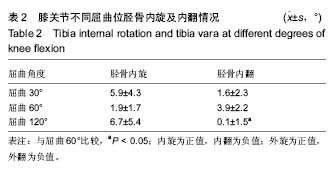| [1] 翟云,高根德,徐守宇. 膝关节骨关节炎的基础研究进展[J]. 中国骨伤,2012,28(1):83-87.[2] 徐小敏.江苏省高校高水平篮球运动员膝关节损伤现状及对策研究[D].苏州大学,2010.[3] 黄伟华.人体膝关节有限元建模及损伤生物力学探索性研究[D].南方医科大学,2014.[4] 樊星.等速肌力测定分析膝关节骨关节炎对膝关节屈伸肌群影响[D].中南大学,2013.[5] 徐小会.全膝关节置换术治疗晚期类风湿性关节炎的中期随访研究[D].第四军医大学,2014.[6] 郑瑜峰.人工膝关节置换前后髌骨高度对膝关节功能的影响[D].第四军医大学,2014.[7] Ip D.Does addition of low-level laser therapy (LLLT) in conservative care of knee arthritis successfully postpone the need for joint replacement? Lasers Med Sci. 2015;30(9): 2335-2339. [8] Barlow T, Dunbar M, Sprowson A, et al.Development of an outcome prediction tool for patients considering a total knee replacement—the Knee Outcome Prediction Study (KOPS).BMC Musculoskelet Disord. 2014;15:451. doi: 10.1186/1471-2474-15-451.[9] 王国伟. 老年骨关节炎患者全膝关节置换术后疗效影响因素分析[D].山东大学,2008.[10] 王鑫瑞,王涛,张志强.全膝关节置换围置换期氨甲环酸的临床应用[J].中国组织工程研究,2015,19(44):7188-7192.[11] 胡勇,谢辉,杨述华.三维有限元分析在脊柱生物力学中应用研究[J].医用生物力学,2006,21(3):246-250.[12] 王一民. 跟骨骨折的有限元分析[D].南方医科大学,2013.[13] Razfar N, Reeves JM, Langohr DG,et al.Comparison of proximal humeral bone stresses between stemless, short stem, and standard stem length: a finite element analysis[J].J Shoulder Elbow Surg. 2016 Jan 22. pii: S1058-2746(15) 00625-4. doi: 10.1016/j.jse.2015.11.011. [14] Allred JJ, Flores-Hernandez C, Hoenecke HR Jr,et al. Posterior augmented glenoid implants require less bone removal and generate lower stresses: afinite element analysis.J Shoulder Elbow Surg. 2016 Jan 14. pii: S1058-2746(15)00574-1. doi: 10.1016/j.jse.2015.10.003. [15] Harith H, Schmutz B, Malekani J,et al.Can we safely deform a plate to fit every bone? Population-based fit assessment and finiteelement deformation of a distal tibial plate[J].Med Eng Phys. 2015 Dec 28. pii: S1350-4533(15)00270-2. doi: 10.1016/j.medengphy.2015.11.012. [16] Wang B,Li L,Chen A.Research on method of rule-based finite element quick modeling//Networking and Digital Society (ICNDS),2010 2nd International Conference on IEEE,2010;2: 540-543.[17] 郑锋,林海滨.人骨三维有限元分析的研究进展[J]. 医学综述, 2011,17(11):1689-1691.[18] 周伊顗.三维建模与有限元分析在眼科和骨科的应用[D].清华大学,2005.[19] 何川.前交叉韧带虚拟重建系统的应用及术后膝关节内结构的三维有限元研究[D].昆明医科大学,2014.[20] 马雪梅,张春秋,高丽兰,等. 骑行时不同屈曲角度膝关节软骨受力分析[J].中国生物医学工程学报,2016,35(1):119-123.[21] 齐玮. 高屈曲状态下膝关节生物力学研究[D].中国人民解放军医学院,2013.[22] 王西十,白瑞蒲.关于人膝关节生物力学模型的研究现状[J]. 力学进展,1999,29(2):101-107.[23] 孙永森.人体膝关节生物力学模型研究[D].大连理工大学,2006.[24] 许玉林,孙允高,张春林. 膝关节生物力学模型研究现状[J]. 医用生物力学,2003,18(4):250-255.[25] 周吉彬,郝智秀,杨义勇,等.人体膝关节韧带生物力学研究进展[J]. 生物医学工程学杂志,2006,23(4):903-906.[26] 刘爱峰,马剑雄,魏强,等.膝关节生物力学模型研究进展[J]. 中国矫形外科杂志,2012,20(19):1774-1776.[27] 孙永森. 人体膝关节生物力学模型研究[D].大连理工大学,2006.[28] Gokkus K, Atmaca H, U?ur L,et al.The relationship between medial meniscal subluxation and stress distribution pattern of the knee joint: Finite element analysis.J Orthop Sci. 2016; 21(1):32-37. [29] Zhu GD, Guo WS, Zhang QD, et al.Finite Element Analysis of Mobile-bearing Unicompartmental Knee Arthroplasty: The Influence of Tibial Component Coronal Alignment.Chin Med J (Engl). 2015;128(21):2873-2878. [30] Tanska P, Mononen ME, Korhonen RK. A multi-scale finite element model for investigation of chondrocyte mechanics in normal and medial meniscectomy human knee joint during walking. J Biomech. 2015;48(8):1397-1406.[31] Feikes JD, O'Connor JJ, Zavatsky AB. A constraint-based approach to modelling the mobility of the human knee joint. J Biomech. 2003;36(1):125-129. [32] Martelli S, Ellis RE, Marcacci M, et al. Total knee arthroplasty kinematics: Computer simulation and intraoperative evaluation. J Arthroplasty. 1998;13(2):145-155. [33] Wilson DR, Feikes JD, O'Connor JJ. Ligaments and articular contact guide passive knee flexion. J Biomech. 1998;31(12): 1127-1136.[34] Galbusera F, Freutel M, Dürselen L, et al.Material models and properties in the finite element analysis of knee ligaments: a literature review.Front Bioeng Biotechnol. 2014;2:54. doi: 10.3389/fbioe.2014.00054. [35] Sun ZH, Liu YJ, Li H.Femoral stress and strain changes post-hip, -knee and -ipsilateral hip/knee arthroplasties: a finite element analysis.Orthop Surg. 2014;6(2):137-144. doi: 10.1111/os.12105.[36] Krouskop TA,Trono R,Adamski AJ.The effects of pylon shape on bone-pylon interface performance in direct skeletal attachment. J Biomed Mater Res.1976;10(3):345-369.[37] Bendjaballah MZ,Shirazi-Adl A,Zukor DJ.Biomechanics of the human knee joint in compression:reconstruction,mesh generation and finite element analysis. Knee.1995;2(2): 69-79. |
.jpg)


.jpg)
.jpg)